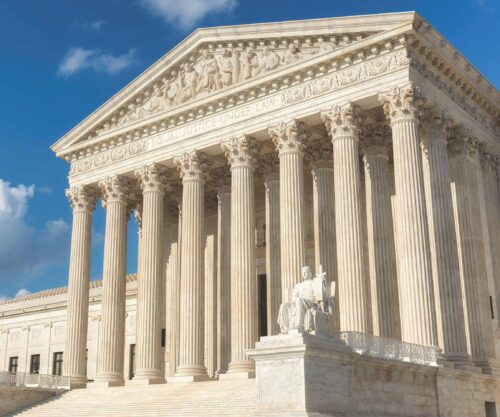Supreme Court permits early challenge to constitutionality of FTC

In a unanimous decision, the Supreme Court of the United States affirmed the existing right to challenge the constitutionality of the Federal Trade Commission (FTC) in federal court first, outside the agency’s administrative process. The decision was issued jointly on two cases:
- Axon Enterprises, Inc v FTC (Axon); and
- SEC v Cochran.
This joint decision raises significant questions for administrative enforcement actions.
While the Court warned that it did not open the flood gates, the decision allows parties to effectively pause administrative enforcement actions while constitutional challenges are heard.
Decision and issues raised
The decision did not resolve the specific constitutional challenges that had been raised about each agency. Both cases involved challenges to the power vested in the administrative law judges (ALJs), the judges who hear the cases initially, make evidentiary rulings and ultimately make a recommended decision for potential adoption by the administrative agency. Both Axon and Cochran argued that the role of the ALJs was too independent of the executive branch and hence lacked effective oversight. But rather than focus on this issue (and a separate issue raised by Axon), the Court focused on the question of timing. Must a respondent wait until the enforcement proceeding is complete to challenge the constitutionality of the agency’s action?(1)
The Court unanimously responded to this question in the negative, but this was conditional. Not every challenge to agency authority may proceed in federal court first. Federal district courts have jurisdiction to hear challenges to the constitutionality of an agency’s structure or existence if the challenge is to the use of agency power irrespective of the outcome of the case. Challenges to how the agencies adjudicate, (eg, the standard or procedure) do not qualify and must wait until the action reaches the federal court on appeal.
For example, Axon made three claims in its original federal court action including:
- that the FTC’s combination of prosecutorial and adjudicative functions was unconstitutional;
- that the authority of the FTC’s administrative judges was an unconstitutional violation of the separation of powers; and
- Axon did not violate antitrust laws in the acquisition challenged by the FTC.(2)
The Court ruled that the first two challenges may proceed in a federal district court first, while Axon’s violation of antitrust law must first proceed through the administrative process.
Justices Thomas and Gorsuch separately concurred in the ultimate result, but took issue with the Court’s starting point that Congress may and did grant administrative agencies primary adjudicative power under the regulatory scheme. Justice Thomas argued that administrative agencies adjudicating private rights was unconstitutional. Justice Gorsuch argued that Congress did not explicitly divest district courts of jurisdiction in establishing the administrative agencies’ powers and, therefore, courts retain jurisdiction.
Comment
The impact of this decision is potentially significant, at least in the near term. While the Court was careful to limit the impact to those cases that challenge the structure and existence of the FTC, it is still an open question as to what those cases may be and whether they are in fact unconstitutional uses of power. Litigants may now pause proceedings to at least litigate whether theirs is a constitutional question that may sidestep administrative enforcement. Indeed, it could be the case that virtually every current administrative adjudication is subject to the same collateral attack pursued by Axon – if the combination of the FTC’s roles as prosecutor (complaint counsel in the administrative jargon) and judge (ie, the decisionmaker) is unconstitutional, it is unconstitutional in all cases. That said, the FTC has procedural rules that prohibit complaint counsel from interacting with the Commission once a matter has moved into adjudication. These rules do not prevent the Commission from voting on whether to issue a complaint to pursue administrative litigation and then from being the ultimate decisionmaker when that litigation reaches it (as it recently did in the case involving Illumina and Grail).
The Supreme Court’s Axon decision must be viewed in the broader context of the shift in the Supreme Court. The composition of the current Court is clearly antithetical to the administrative state. This is perhaps best demonstrated by the Court’s recent decision to hear a case(3) that specifically raise the question of whether the Court should overrule or limit Chevron v Natural Resources Defense Council, which stands for the proposition that the courts should defer to the expertise of the administrative agency when:
- that agency is interpreting an ambiguous statute that it is required to administer; and
- the interpretation is reasonable.
The Chevron deference has been heavily criticised by Justices Gorsuch and Thomas in particular.
What makes this area of critical importance today is the tension that it creates with the broad progressive agenda – while the FTC (and the Department of Justice) are attempting to mold antitrust away from the consumer welfare standard, oftentimes in opposition to the case law, the FTC’s entire structure is under attack, permitted by an anti-administrative state Supreme Court.
Endnotes
(1) For more details, see “Axon v FTC: where are they now?“
(2) For more details, see “FTC under attack as parties challenges its structure and participation of chairperson“.
(3) Loper Bright Enterprises v Gina Raimondo, Secy of Commerce
This content was originally published on May 25, 2023, via the International Law Office (ILO) newsletter. It can be found here: Supreme Court permits early challenge to constitutionality of FTC
ILO delivers expert legal commentary, in the form of concise weekly newsletter emails, to senior corporate counsel and law firm partners worldwide. Free to receive, the ILO newsletters have been providing tailored, quality- assured updates on global legal developments to more than 70,000 registered subscribers since 1998. ILO content is generated in collaboration with over 500 of the world’s leading experts and covers more than 100 jurisdictions.
